MB&F
Introducing the MB&F Legacy Machine Sequential EVO
MB&F
Introducing the MB&F Legacy Machine Sequential EVO
Having addressed traditional complications such as the tourbillon and the perpetual calendar in imposingly innovative ways, the brand has now unveiled its first chronograph – the Legacy Machine Sequential EVO. Like the 2015 Legacy Machine Perpetual, the movement was conceived by the talented Northern Irish watchmaker Stephen McDonnell. It’s rarely ever that the following can be said about chronographs, but this is unlike anything we’ve seen before in chronographs in every way — construction, function and aesthetics. It houses two vertically coupled, column-wheel chronographs and features a groundbreaking ‘Twinverter’ binary switch, allowing multiple timing options including split-seconds and lap timer modes. Impressively, they all run on a single escapement and balance, rather than two independent trains, which speaks volumes of its complexity and holistic design. Moreover, the construction is consistent with the Legacy Machine range, where the mechanics are exposed on the dial and a balance wheel is suspended high above it by an elegantly arched balance bridge.
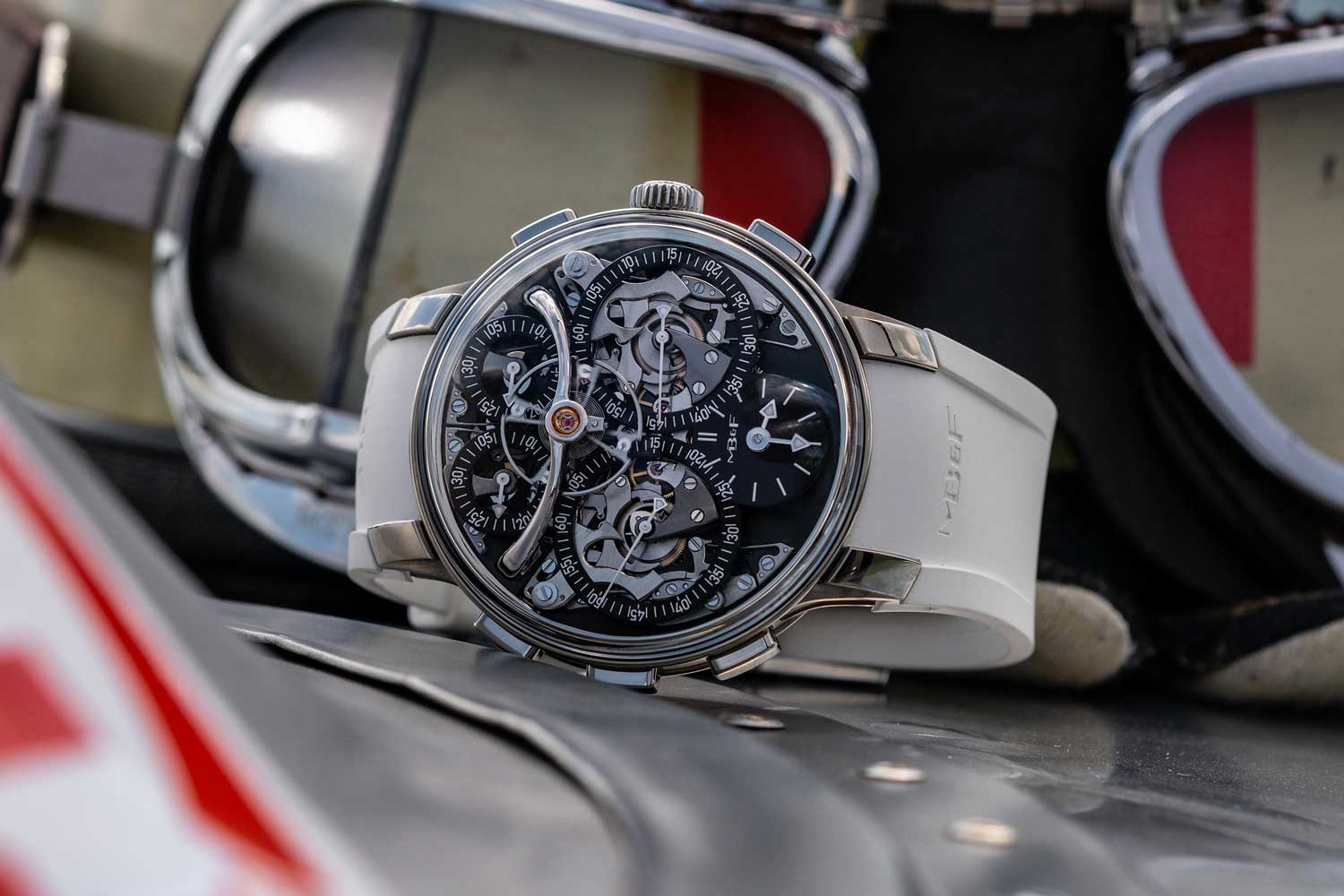
MB&F Legacy Machine Sequential EVO in coal black dial
Twinverter
Available in either atomic orange or coal black, the dial features two symmetrical, openworked chronograph displays with a pair of chronograph seconds counters located at nine and three o’clock, and a pair of 30-minute totalizers positioned at 11 and one o’clock respectively. Each chronograph can be started, stopped and reset completely independently from each other via the usual two-pusher configuration on either side of the case — start/stop pusher at the top and reset at the bottom. But where it differs dramatically from any other chronograph in function is the presence of a fifth pusher, located at nine o’clock, that acts as a binary switch dubbed the ‘Twinverter’ that inverts the current start/stop status of each chronograph. If both chronographs displays have been stopped, pressing the switch causes both of them to resume or start simultaneously, while if both of them are running, pressing the switch starts both chronographs; and lastly, if one chronograph is running and the other has been stopped, the Twinverter stops the one that is running and starts the one that is stopped.
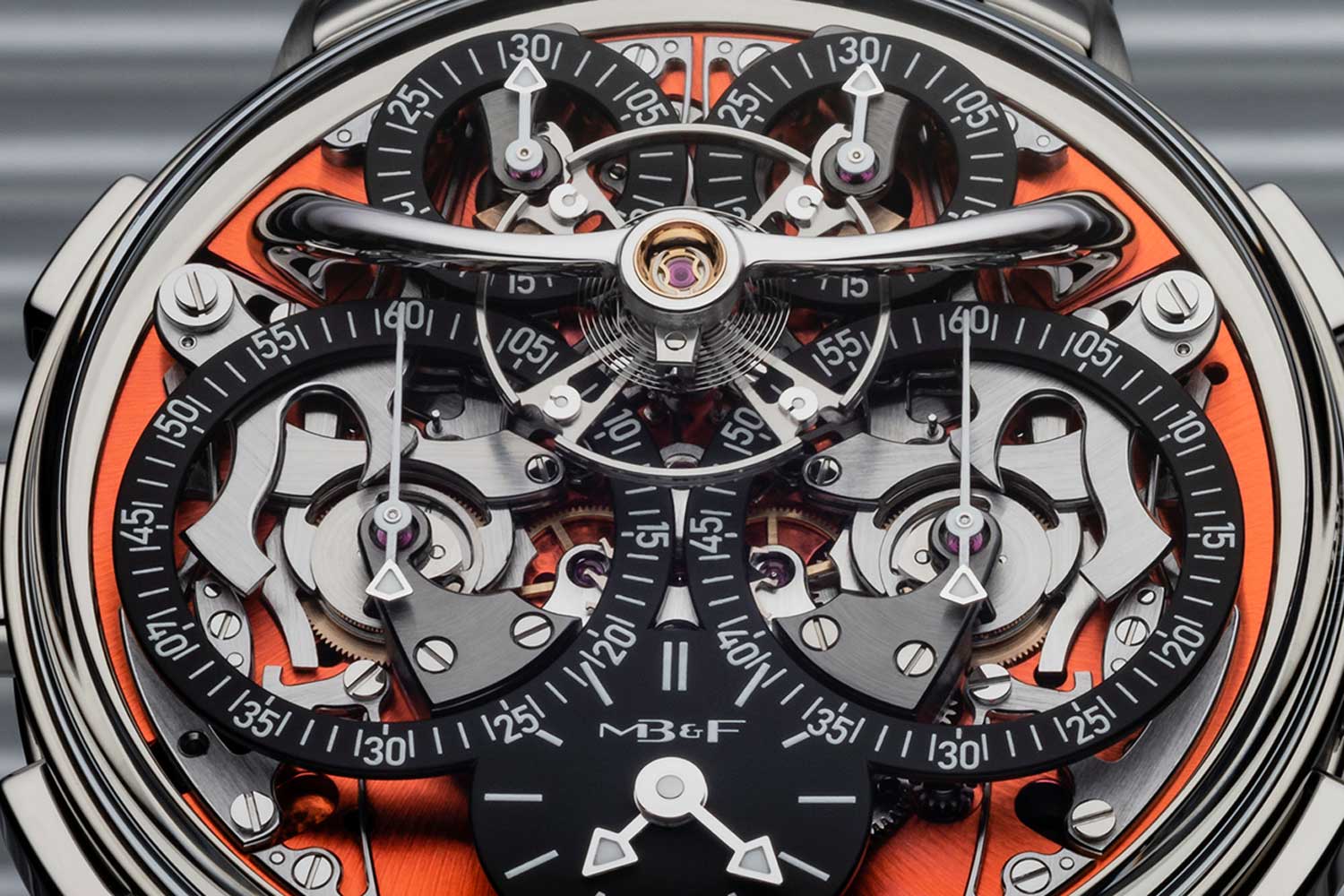
The dial features with two symmetrical, openworked chronograph displays
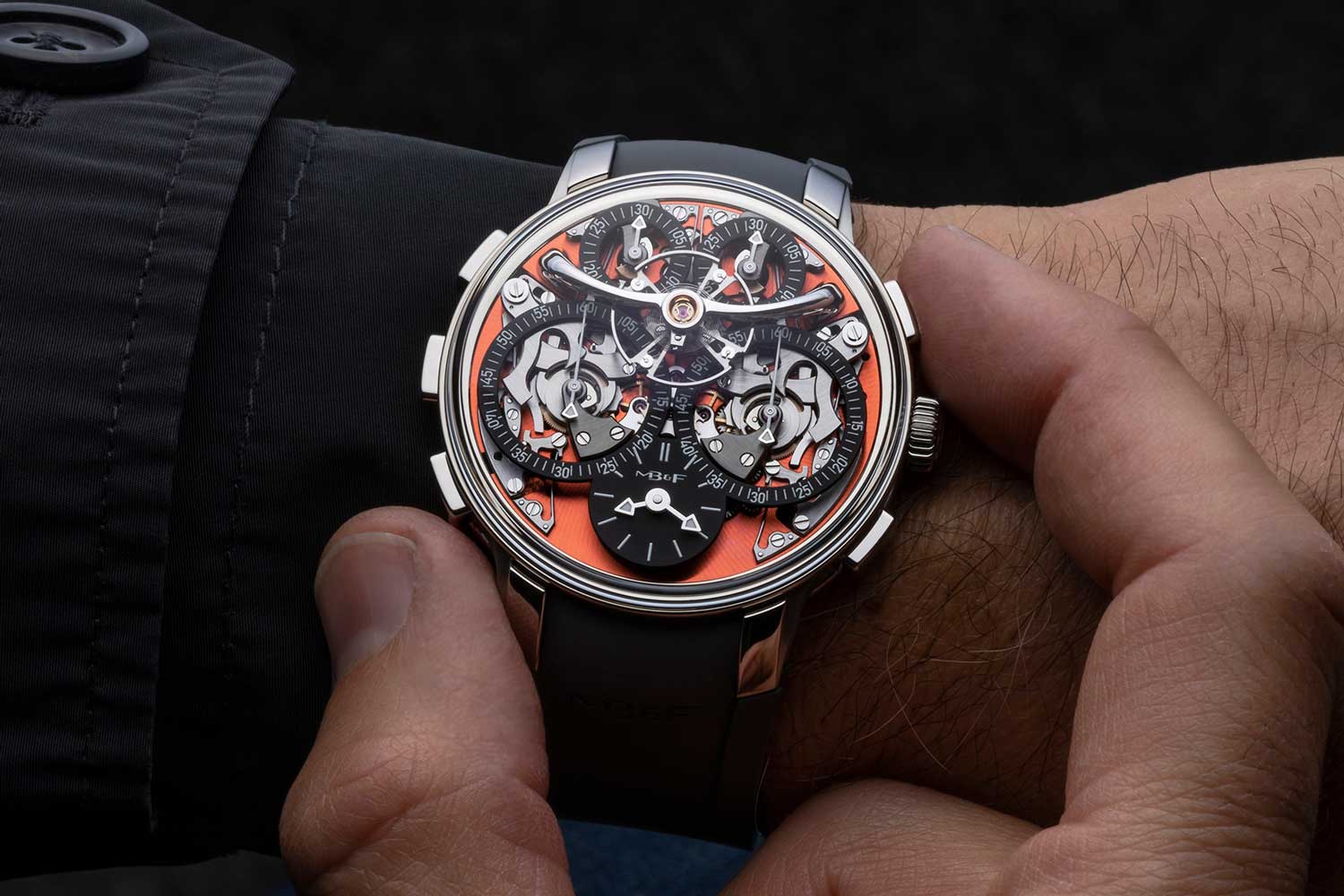
Two-pusher configuration on either side of the case
Lastly, it can be used to time the sub-durations of a single continuous event, akin to a lap timer. Actuating one chronograph at the start of an event and using the Twinverter upon the completion of a lap stops the chronograph and instantly launches the second chronograph to time the next lap, allowing ample time for the first timing result to be recorded.

MB&F Legacy Machine Sequential EVO in atomic orange dial
Ingenious Construction
The most impressive aspect of the Legacy Machine Sequential EVO is how its novel and ingenious construction manages to conform to the signature aesthetics of the range. In fact, the basic architecture of the main plate bears some similarities to the Legacy Machine Perpetual. The movement is equipped with double barrels installed in a parallel configuration. They each power a gear train for the respective chronographs with the fourth wheels integrated in the vertical clutch assembly, visible at the center of the chronograph seconds counters. This is an exceedingly rare instance in which a vertical clutch mechanism can be seen in action, moreover on the dial, as due to its compactness, it is often used in automatic movements and is consequently obscured by the self-winding mechanism.
When the chronograph is activated, a pair of arms releases the chronograph seconds wheel onto the fourth wheel, causing the chronograph seconds hand to spring into action. The barrel at six o’clock also drives the motion works for the hour and minutes as well as a reduction gear train for the power reserve indicator located at five o’clock on the reverse.
A subtle and unusual element is the fact that the vertical clutch assemblies are actually driving two massive wheels that dominate the case back. In turn, these wheels drive the minute totalizers. This is a deviation from a standard chronograph, in which the minute counter is directly tripped to the next minute by a finger on the chronograph seconds wheel.
The main gear trains are outlined in the image below. Each fourth wheel drives a tiny intermediate wheel, which drives the escape wheel on the dial. And as is characteristic of the range, the dial is dominated by a large 3Hz balance suspended high above by beautifully black-polished and rounded bridges.

Realizing the true merit of a vertical clutch
Notably, this construction also realizes the true merit of a vertical clutch system, avoiding potential causes of seconds hand stutter, which is a key advantage over a horizontal coupling system. As a recap, vertical clutches are of a co-axial structure in which the chronograph seconds wheel and drive (or fourth) wheel are located concentrically on the same axis. When the chronograph is switched on, a pair of arms releases the clutch, dropping the chronograph wheel onto the running wheel. Both wheels are driven together by friction, causing them to turn in tandem.
In this ideal configuration, there is no meshing of teeth when the chronograph starts as both wheels are already on the same arbor. However, there are many possibilities in gear arrangement of the main train, with the most common configuration being the positioning of the fourth wheel at six o’clock to drive the running seconds directly. As such, having all three components — fourth wheel, vertical clutch mechanism and chronograph seconds wheel — stacked vertically in the middle of the movement is a format that happens more rarely than perceived.
In the event where the fourth wheel is located elsewhere to drive a running seconds counter directly, an auxiliary train is necessary to connect the fourth wheel to the chronograph wheel in the middle. This horizontal mating of gears in turn reintroduces the issue of backlash, caused by gaps between meshing teeth, necessitating other solutions such as a tensioner to reduce flutter and prevent the chronograph seconds hand from stuttering.
In the Legacy Machine Sequential EVO, the fourth wheel is integrated in the vertical clutch and chronograph seconds assembly, visible on the dial side. As such, there is no additional meshing of teeth when the chronograph starts or stops, and hence no stutter during the engagement process.
The second problem that plagues vertically coupled chronographs is the loss of amplitude when the chronograph is not running. This is because the shaft of the fourth wheel, which houses the shaft of the vertical clutch, is left running on its own against the the clutch shaft, generating friction. To address this, jewels are incorporated in the fourth wheel shaft to eliminate friction in the Legacy Machine Sequential EVO.
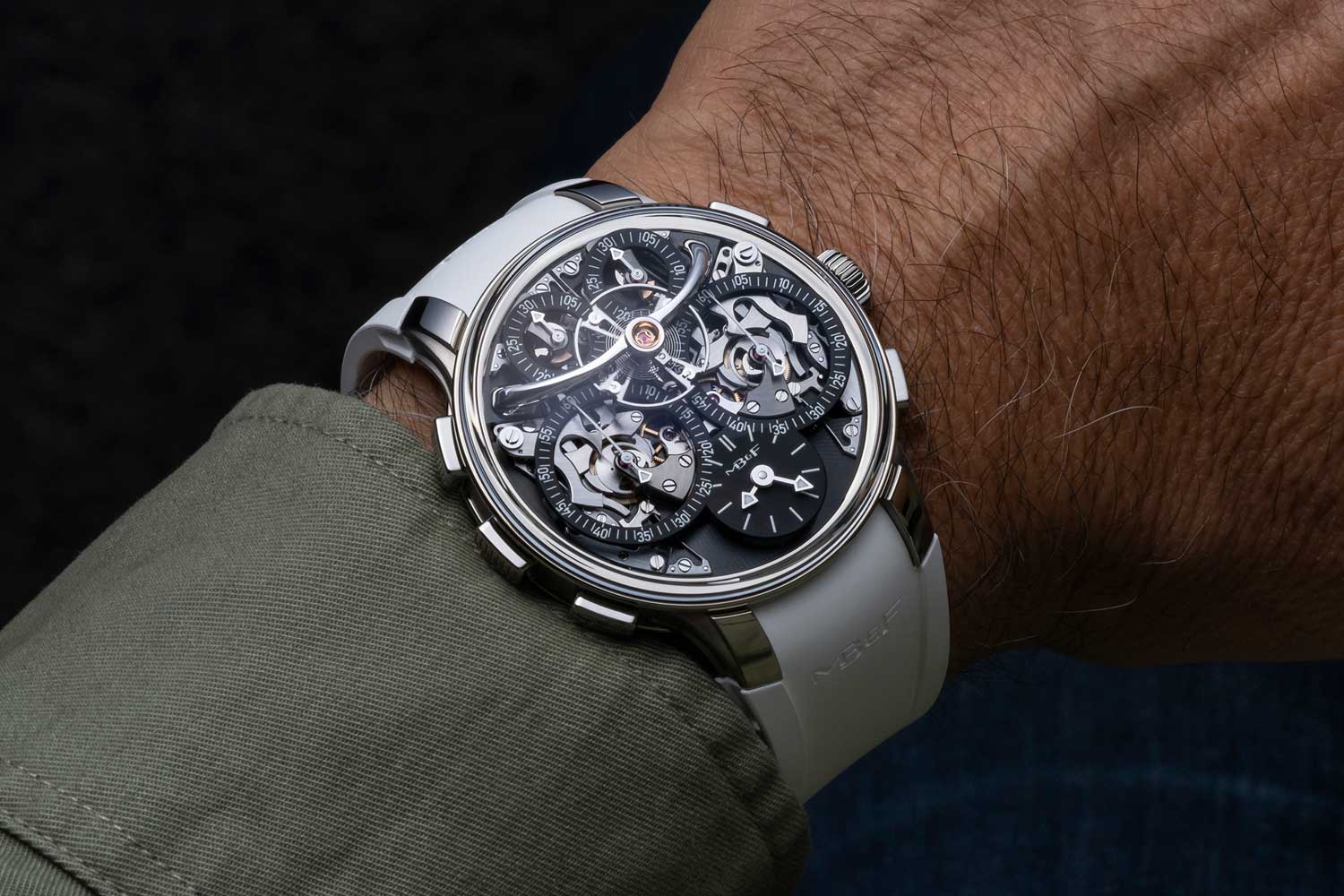
MB&F Legacy Machine Sequential EVO in coal black dial
Engineered for sports
The movement is housed in an EVO case which is essentially a fortified and enhanced variation that first made its debut in the Legacy Machine Perpetual EVO in 2020. It is made of zirconium, a hypoallergenic metal that is lighter than steel and more durable than titanium. Measuring 44mm by 18.2mm, the case is notably complex with a recessed caseband and angular lugs that accommodate an integrated rubber strap.
Its bezel-free design sets the stage for the perfectly symmetrical movement. Instead of the usual domed crystal with a highly pronounced arch, which will only add height to the already thick movement, the crystal incorporates two subtle angles to form a smooth arch and keep its height at the minimum.
Most notably, the EVO case incorporates an annular shock-absorbing system, dubbed ‘FlexRing’, fitted between case and movement. Machined from a single block of stainless steel, it encircles the movement and fortifies it from the rigors of an active lifestyle. Lastly, the case also features a screw-down crown to provide a water resistance of 80 meters.
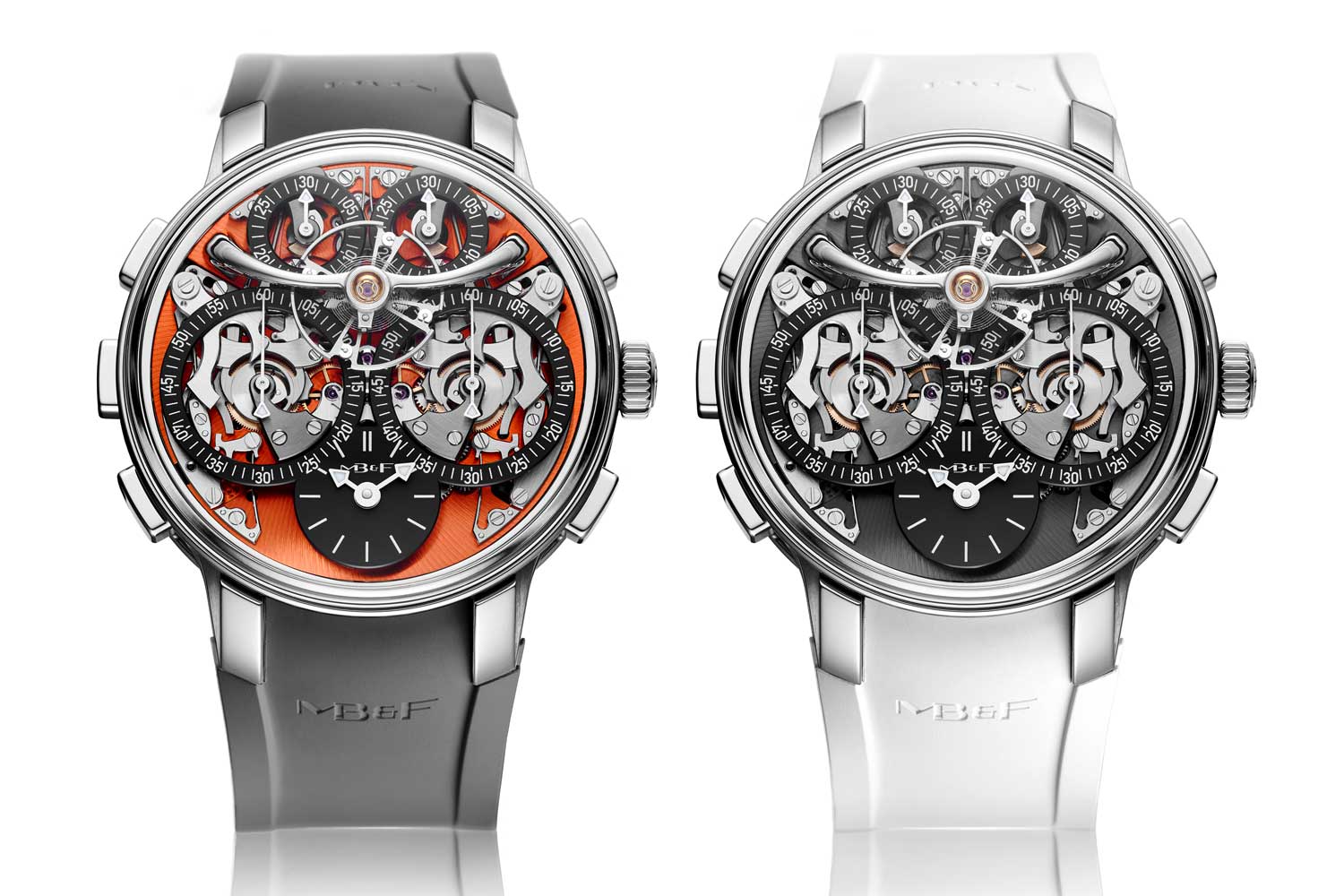
MB&F Legacy Machine Sequential EVO
Tech Specs
Legacy Machine Sequential EVO
Movement: Manual-winding with double mainspring; 3Hz (21,600 vph); 72 hours of power reserve
Functions: Hours, minutes, seconds, double chronographs, Twinverter, power reserve indication
Case: 44mm x 18.2mm; zirconium; water resistant to 80m
Strap: Integrated rubber strap with titanium folding buckle
Price: CHF 160,000, or USD 180,000











